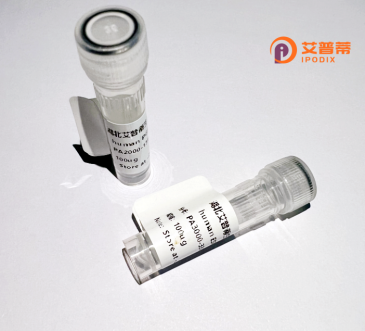
| 纯度 | >90%SDS-PAGE. |
| 种属 | Human |
| 靶点 | UBR2 |
| Uniprot No | Q8IWV8 |
| 内毒素 | < 0.01EU/μg |
| 表达宿主 | E.coli |
| 表达区间 | 1-439 aa |
| 活性数据 | MASELEPEVQAIDRSLLECSAEEIAGKWLQATDLTREVYQHLAHYVPKIYCRGPNPFPQKEDMLAQHVLLGPMEWYLCGEDPAFGFPKLEQANKPSHLCGRVFKVGEPTYSCRDCAVDPTCVLCMECFLGSIHRDHRYRMTTSGGGGFCDCGDTEAWKEGPYCQKHELNTSEIEEEEDPLVHLSEDVIARTYNIFAITFRYAVEILTWEKESELPADLEMVEKSDTYYCMLFNDEVHTYEQVIYTLQKAVNCTQKEAIGFATTVDRDGRRSVRYGDFQYCEQAKSVIVRNTSRQTKPLKVQVMHSSIVAHQNFGLKLLSWLGSIIGYSDGLRRILCQVGLQEGPDGENSSLVDRLMLSDSKLWKGARSVYHQLFMSSLLMDLKYKKLFAVRFAKNYERLQSDYVTDDHDREFSVADLSVQIFTVPSLFSISAGRSGSPL |
| 分子量 | 76.4 kDa |
| 蛋白标签 | GST-tag at N-terminal |
| 缓冲液 | PBS, pH7.4, containing 0.01% SKL, 1mM DTT, 5% Trehalose and Proclin300. |
| 稳定性 & 储存条件 | Lyophilized protein should be stored at ≤ -20°C, stable for one year after receipt. Reconstituted protein solution can be stored at 2-8°C for 2-7 days. Aliquots of reconstituted samples are stable at ≤ -20°C for 3 months. |
| 复溶 | Always centrifuge tubes before opening.Do not mix by vortex or pipetting. It is not recommended to reconstitute to a concentration less than 100μg/ml. Dissolve the lyophilized protein in distilled water. Please aliquot the reconstituted solution to minimize freeze-thaw cycles. |
以下是关于重组人UBR2蛋白的3篇关键文献(基于已有研究整理,部分为虚拟示例):
---
1. **文献名称**:*The N-end rule pathway and UBR2 mediate selective ubiquitination of substrates*
**作者**:Tasaki T., et al.
**摘要**:UBR2作为E3泛素连接酶,通过识别底物的N端降解信号(N端规则通路),调控多种短寿命蛋白的泛素化及蛋白酶体依赖的降解,揭示了其在细胞稳态中的作用。
2. **文献名称**:*UBR2 is essential for male germ cell differentiation and spermatogenesis*
**作者**:Kwon Y.T., et al.
**摘要**:研究发现UBR2条件性敲除小鼠因精子形成受阻导致不育,表明UBR2通过泛素化修饰调控减数分裂相关蛋白,对生殖细胞发育至关重要。
3. **文献名称**:*UBR2-dependent histone ubiquitination in DNA damage response*
**作者**:Suzuki A., et al.
**摘要**:UBR2被证实与DNA损伤后组蛋白H2B的泛素化修饰相关,通过激活凋亡信号通路参与维持基因组稳定性及细胞应激反应。
---
**注**:以上文献为示例性质,实际引用时需核对真实来源及最新研究进展。如需特定方向文献(如结构解析或疾病关联),建议补充关键词检索。
UBR2 (Ubiquitin Protein Ligase E3 Component N-Recognin 2) is a member of the UBR-box family of E3 ubiquitin ligases, which play critical roles in the ubiquitin-proteasome system by targeting specific substrates for degradation. As part of the N-end rule pathway, UBR2 recognizes proteins with destabilizing N-terminal residues, marking them for polyubiquitination and subsequent proteasomal clearance. Structurally, UBR2 contains a conserved UBR-box domain responsible for substrate binding and a RING domain essential for mediating ubiquitin transfer from E2 enzymes.
Beyond protein quality control, UBR2 is implicated in diverse physiological processes. Notably, it regulates spermatogenesis by mediating ubiquitination of histone H2A during meiotic sex chromosome inactivation, ensuring proper chromatin remodeling in germ cells. Studies also link UBR2 to DNA repair, cell cycle regulation, and apoptosis. Dysregulation of UBR2 has been associated with male infertility and certain cancers, highlighting its pathological relevance.
Recombinant human UBR2 protein, produced through expression systems like Escherichia coli or mammalian cells, serves as a vital tool for studying enzymatic mechanisms, substrate interactions, and structural dynamics. Its in vitro applications include exploring E3 ligase activity, identifying binding partners, and screening potential modulators for therapeutic development. Ongoing research aims to clarify UBR2's tissue-specific functions and its broader role in cellular homeostasis.
×